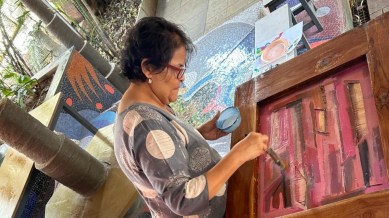Click here to join Express Pune WhatsApp channel and get a curated list of our stories
Award-winning artist lets distressed ship planks, salvaged roofs and papyrus guide her abstract imagination
On September 19, Dharap's first show in Pune in three years, “Found Surfaces” opens at Monalisa Kalagram in Koregaon Park.

Pune-based artist Sujata Dharap was walking in a huge furniture godown in Bali a few years ago when she found some planks lying in a corner — distressed wood, from old ships. This wood has several layers of colour as a buyer of an old boat will always colour it again. Several colours overlap on wood, adding an extra dimension to “wood that has seen the wind, rain, sunshine and other elements of life”.
Dharap recalls being fascinated by the colours and the texture of the wood in that Bali godown. “I said that I wanted these. I did not have anything in mind at that time. We just bought them and my husband asked, ‘What are you going to do with it?’ I said, ‘I don’t know. I want these in my studio and I will do something from these,” says the award-winning artist, whose career spans 40 years and more than 30 solo and dual shows in the country and abroad.
monthly limit of free stories.
with an Express account.
On September 19, Dharap’s first show in Pune in three years, “Found Surfaces” opens at Monalisa Kalagram in Koregaon Park. The exhibition will be held till October 5. On display are works inspired by the distressed wood that Dharap had found in Bali. There are also salvaged plywood and papyrus, considered the oldest writing surface in the world.
The distressed wood stood in Dharap’s studio almost a year-and-a-half while she figured out what she wanted to do. “I wanted to leave them just as they are. So, I decided to make very broad edges of those planks. That was the starting point of my work,” says Dharap. An abstract artist, Dharap created paintings to fit the wood that became the edges of the works. “I don’t call it ‘a frame’ but ‘an edge’. This was a paradigm shift because, normally, you do the framing as the last thing for a work. When I made the edge, according to the sizes and shapes, the edge told me what to do. Every edge had a story to tell and I went and embraced the story,” says Dharap.
There are dramatic edges and, consequently, enough drama in the work. The works are not titled but the series they belong to have particular names, such as Outer Edge, which covers the works with distressed wood, and Saad Pratisad, in which she has worked on a wooden roof that her friend was ripping off and discarding as scrap. Another series, with papyrus, goes back to her travels in Egypt when Dharap watched a demonstration with papyrus. “You can put it in water and squeeze it and, again, open it out and it dries and becomes the same material,” she says. The works maintained the original character of the papyrus.
“I did not kind of trim them and clean them up. I wanted the character of the uneven edges of the papyrus,” she says. She has 30 small works on papyrus that talk about everything – the sky, structures, architecture, natural bamboo. “All these stories are coming out of the papyrus works,” says the artist, adding that it is time for art lovers of Pune to hear the stories of old material.
Click here to join Express Pune WhatsApp channel and get a curated list of our stories